
|
Note ye ed's email address: stevebryant99@gmail.com. |

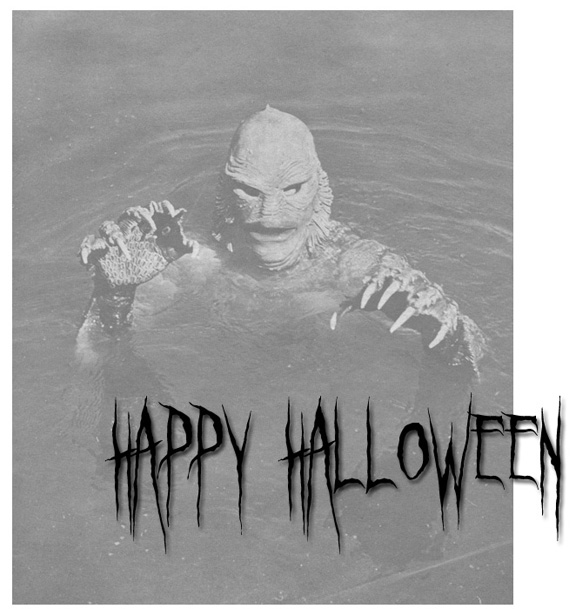
|
October 2011 Some of the opening palaver in my scary card trick act is that I grew up on the drive-in horror movies of the 1950s. It's true, and I still love those cheesy black and white flicks more than some of Hollywood's more modern attempts. (A recent exception is Attack the Block, a fine British monster movie.) Anyway, in honor of those classics we grew up on, we'll revert to black and white for this edition of Little Egypt Magic. Addressed this month are Dave Buck's If an Octopus Could Palm, Helder Guimaraes' Ontology Project, Steve Beam's The Trapdoor Volume Two, Roger Ebert's Life Itself, Kirk Demaris's Mail-Order Mysteries, and a John Lovick installment of Fitzgerald's Who's Hoo. Ah, and only a few more days before it's time to trick or treat. That knock on the door might be me. Happy Halloween and, even though it has no connection to magic, happy 85th birthday to Chuck Berry. Rock on. |
|
|
OCTOPI HIGH -- When it comes to palming, I am an advocate of the Eugene Burger seven-word school of palming a card: "Just push it over with your thumb." In most cases, with a little attention to timing and misdirection, that advice serves me well and is all I need. Why, then, would I invest in what appears to be a pricey coffee table book on the subject by Dave Buck? Ah, first, because the book, with the surreal title If An Octopus Could Palm, is gorgeous. I wanted one as soon as Chris Kenner let me browse through his copy at MAGIC Live! The Jean Luis Bunuel cover illustration, on a brilliant blue background that repeats throughout the book, depicts an octopus with cards at the extremities of six of its tentacles. A clever rhyming couplet by Derek DelGaudio and/or John Lovick serves as an epigraph to each titled sleight ("A card's turned face up; we see the selection/ It's switched for another after a secret ejection"). Cartoons of octopi by Ricky Smith add charming whimsy to the pages. And finally, the hand drawings that illustrate the sleights are spare and graceful, and the layout is striking, with colorful, stylized headlines. |
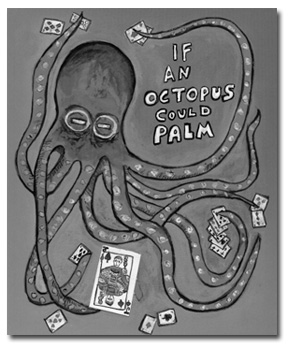 Tentacles. |
|
Second, the palms are, as expected, outside the box and interesting. Specifically, among the sixteen titled items, there are eight palms, one control, two card switches, two hand-to-hand transfers, two palm replacements, and one false extraction of a card from its case. There are additionally two bonus palms, a page of references, a section of recommended reading, and a glossary by Jason England. 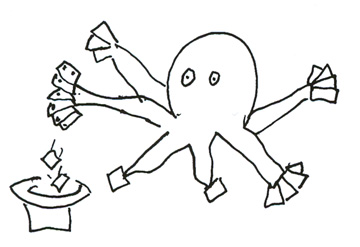 As Vivaldi plays in the background. I enjoy Dave's (and his brother Dan's) writing. They speak with a gravitas that reminds me of a young Steranko. Their revolutionary methods remind me of those of a young Jerry Andrus. (I recall laughing once, when seated beside Jerry, and I had an exposed view of his Panoramic Shift. It's an outrageous move.) Several of the palms are overtly impractical, yet most are fun to practice. I've practiced some Andrus sleights for over forty years and have yet to show them to a single spectator. Certainly the most difficult, for a beginner, is Mimic Palm, a one-hand palm performed while executing a one-hand shuffle. Possibly the most practical is Derek DelGaudio's Plumber Palm, executed during an overhand shuffle. Whatever, if you love card magic, and are not into it only for commercial plots, you'll find plenty here to keep your hands busy and just may find a perfect palm or replacement to meet the need of some routine you are working on. Hardbound with handsome dust cover, 90 big square pages, $64.95 plus postage, including a commemorative deck of playing cards. | |
|
|
LAB NOTES -- If you log on to Journal of Secrets, you will find two tabs, manifesto and ontology project. The Manifesto, which is free, makes for interesting reading and, if followed, is probably worth far more to you than the $40 Ontology Project, to be discussed next. But to it: The Ontology Project is a kit from Helder Guimaraes (with Derek DelGaudio), the kit consisting of a very gaffed deck of cards and a booklet explaining its uses. The cards contain four banks of special cards (to be combined with ordinary cards from a matching deck) with which to do five routines. Deepest Sympathy is a squeaky clean Sympathetic Cards routine; Triumphant is a version of Triumph in which the clearly mixed-up cards wind up in perfect order at the climax, with the selection in its proper location; Cart Before the Horse is a version of Hamman's The Signed Card using only two jokers and one face-down card for the climax; and Force of Nature is a gaffed force for which two uses are provided. If you check out the web site, you can see Helder performing these items and how very, very clean and convincing they look. 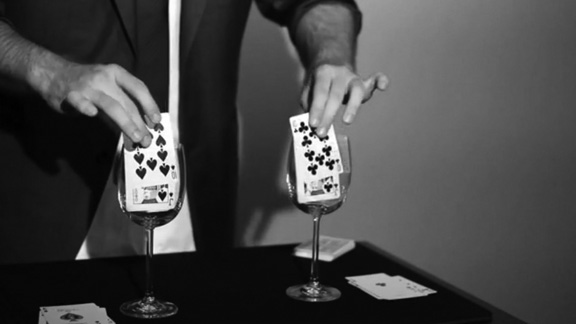 And the cards match! Whether you are willing to achieve that impact at the expense of using gaffed cards is up to you. For example, I am seriously looking forward to performing Deepest Sympathy, especially in a parlor situation. For close-up, to stake my reputation on the effect, I would stick with ordinary cards and perform Caleb Wiles' 24!, also a stunning routine. For a non-gaffed version of Triumph in which the same kicker result is achieved, I recommend the Tamariz idea discussed in the December 2004 issue of this sheet. And yet, for sheer visual magic, you might prefer the gaffed version. These are merely choices and not meant in any way to disparage what these cards can do for you. And you will very likely fool brother magicians with them. Take another look at the web site; this stuff looks like the real deal. A deck of special cards and a 36-page book, illustrated with color photos, nicely packaged. $40. You may order the cards in red or blue Bicycle backs. |
|
|
WHAT'S DOWN IN THE CELLAR? -- "At the bottom of the stairs, turn right. The meter is on the far wall," Morticia tells the meter reader in a famous Charles Addams cartoon. The fellow looks apprehensive as he gazes into the darkness beyond the trapdoor. There is no need to feel apprehensive about the contents of The Trapdoor Volume Two, from Steve Beam. It's another concrete block of a book, both physically and in the density of fine material. My only regret, as I write, is that I've had so many house guests this month that I haven't given it proper attention, and my notes here are based on a light skimming. This second volume adds five more years to the hardbound Trapdoor library, 1989-1993 (pp 446-920, plus lots of other pages with little Roman numerals). There are multiple entries from the likes of Richard Bartram, Ken Krenzel, Wayne Kyzer, Harry Levine, Steve Pressley, John Riggs, Scott Robinson, and Harvey Rosenthal. I was especially pleased to find multiple contributions from Jack Birnman, a favorite personal source for miracles. Chris Kenner contributed Battle of the Bands, a strong rubber band routine; there are many others in this volume. And of course, writing and illustrating it all with typical humor and precision and contributing himself is Steve Beam. "You've got plenty of time. Let's fill it with some card tricks before you die."
In an interesting Introduction, Steve measures the importance of The Trapdoor relative to the other magazines of its era. There are 72 pages of issue-by-issue commentary, multiple cross indexes, and bonus material to guide you through this considerable resource. Of the tricks, I'll mention two that stand out, both by Steve Beam. Community Property is a really funny presentation for the bill switch that did not make it into John Lovick's mammoth Switch. It should have (along with the "Southern" presentation tagged along at the end). The Floating Lady is an impromptu levitation of a card off a deck. I've seen many versions, including gaffed versions, and this is the best. Huge at 576 large pages, hardbound, $90 from Steve Beam. Must reading. |
|
|
SECRETS REVEALED --My favorite movie critic in like, forever, is Roger Ebert. I first heard of Roger when I was a student at the University of Illinois, where he was editing The Daily Illini. I have of course followed his career ever since, as he is our most famous alumnus with the exception of Hugh Hefner. This month I had the pleasure of reading his biography, Life Itself, A Memoir. It is thoroughly enjoyable on many levels, even more so for me because of the university connection and because we both enjoyed Dan Curley as a writing instructor. (Roger has profited far more from that association than I.) Although Roger's early interests parallel many of those of my friends in and out of magic, I found only one specific "magic" note: "I was not gifted at sports but was sought after as an entertainer. I had the knack of reading a book and repeating its dramatic highlights. I'd walk around the block regaling my followers with the career of Harry Houdini." A great book, and there were many passages at which I laughed out loud. Highly recommended. Hardbound, 436 pages, $27.99 | |
 Buy a gadget to Throw Your Voice. |
X-RAY SPEX -- For only a buck, you could order X-ray Vision spectacles that would allow you to "see bones through skin" and, even better, "see through clothing." These and dozens of other too-good-to-be-true items that you could order from the back of comic books are the subject of Mail-Order Mysteries, a delightful hardback by Kirk Demaris. The author not only presents the original ads, but descriptions and photos of what kids actually received, coupled with a rating of Customer Satisfaction. Talk about Trickery 101. The "House of Horrors" chapter features the likes of 7 Gigantic Dinosaurs, Genuine Soil from Dracula's Castle, Bloody Finger, and an assortment of masks. The "Trickery" chapter features Mystic Smoke (from finger tips), Sneezing Powder, Itching Powder, Bullet Hole decals (I loved mine!), Fly in Ice, 7-11 Magic Dice, Flashing Eyes, King Tut Mummy, and so on. And who didn't want a Polaris Nuclear Sub ($6.98, "big enough for two kids") or a Jet Rocket Space Ship ($2.98), even if they were made from cardboard? A nice trip down memory lane. Hardbound, 158 pages, $19.95. |
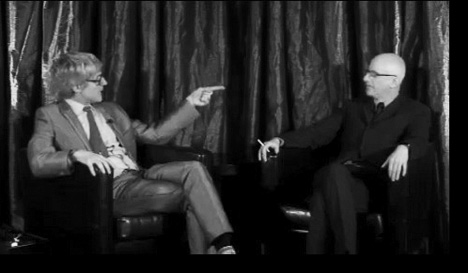 Fitzgerald and John Lovick about to mix it up. MAD JACK -- As I've mentioned John Lovick (aka Handsome Jack) a couple of times above, I should go all out and mention that he was one of the interviewees (along with some other guy named Jason Alexander) this month on Fitzgerald's Who's Hoo, the online Magic Castle talk show. At one point John loses it in mock rage and attacks Fitzgerald for "spreading the word" that he (John) is negative re other magicians. It's a really funny bit. Buried in all this was the news -- I think it was genuine -- that John is writing a book of all his stand-up material. Wow. This means I can start working on my Handsome Steve act. No, wait, that ship has sailed (or never came into port). Perhaps I can change some wording and make it an Old Steve act. No, wait, that was Billy McComb's act ... | |
|
Boo!
Little Egypt Magic is the erratically updated web site of Steve Bryant, spawned (the site, not Steve) by a former internet magazine known as The Little Egypt Gazette/for magicians only. Steve Bryant is an obscure magician and writer who generates this site from an iMac in Bloomington, Indiana. He frequently journeys to and performs magic in Little Egypt, the local name for extreme southern Illinois, where the towns bear such names as Cairo, Thebes, and Karnak. Past issues of this web site: Index to Past Issues Notice: Any limited use of copyrighted images or quoted text is considered fair use, usually to review whatever product or event that is under discussion. If you object to use of any material, please get in touch and it will be cheerfully removed. |
A JSB Creations product
Copyright© 2011 by Steve Bryant